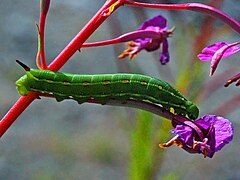- Sphinx galliivon Rottemburg, 1775
- Sphinx galliDenis & Schiffermüller, 1775
- Deilephila canadensisGuenée, 1868
- Deilephila chamaeneriiHarris, 1839
- Deilephila galiiKirby, 1892
- Deilephila intermediaKirby, 1837
- Deilephila oxybaphiClemens, 1859
- Sphinx epilobiiHarris, 1833
- Celerio galiiKuznetsova, 1906
- Celerio gallii chishimanaMatsumura, 1929
- Celerio gallii flavescensCloss, 1920
- Celerio gallii griseaTutt, 1904
- Celerio gallii grisescensBandermann, 1932
- Celerio gallii heliophilaEichler, 1971
- Celerio gallii incompletaTutt, 1904
- Celerio gallii lataTutt, 1904
- Celerio gallii nepalensisDaniel, 1961
- Celerio gallii pallidaTutt, 1904
- Celerio gallii postrufescensLempke, 1959
- Celerio gallii sachaliensisMatsumura, 1929
- Celerio gallii scholziStephan, 1924
- Celerio gallii strictaTutt, 1904
- Celerio gallii testacea(Wladasch, 1933)
- Celerio gallii tibetanicaEichler, 1971
- Deilephila gallii cuspidataFritsch, 1916
- Deilephila gallii dentataGschwandner, 1912
- Deilephila gallii luteaGschwandner, 1912
- Deilephila gallii maculiferaKlemensiewicz, 1912
|











